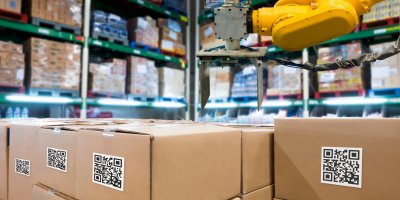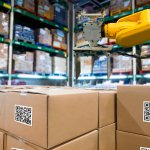
Technology adoption in the supply chain industry is going to have far-reaching consequences. Source: Shutterstock
Everything you need to know about the future of tech in logistics
LOGISTICS and supply chain is a US$5 trillion dollar industry today and is expected to grow to three to four times the size in the next few years.
With rapid globalization, better market access, and phenomenal e-commerce growth, the logistics and supply chain industry supports businesses across the world.
Naturally, with technology disrupting the industry — including ranking Amazon as the biggest threat to FedEx — there are many questions about the future of logistics and supply chains and their impact on businesses that rely on them to move materials and deliver products.
To find answers to some of the popular questions on the minds of business leaders, Tech Wire Asia spoke to supply chain veteran Stephanie Krishnan — Research Director at IDC Manufacturing Insights and Member of the Advisory Board at the Logistics & Supply Chain Management Society.
Tech Wire Asia: Blockchain’s use in the supply chain space is expected to bring in a significant transformation. However, that hasn’t taken off despite projects supported by companies such as IBM and Maersk. Why do you think this is and when do you think blockchain will see industry-wide use?
Stephanie Krishnan: Blockchain is a promising technology, with many potential supply chain applications. These include track and trace, provenance, control over data allowing companies to permit and rescind data visibility, therefore ensuring privacy, and trust and smart and autonomous contract execution.
The first two are where most of the current use cases are seeing expansion beyond pilot as they are within the capability of current blockchain protocol limitations. However, to be used for smart contracts, where rules around agreements are defined and automatically executed, blockchains must be able to transact quickly at scale.
In some financial situations, where transactions occurred at a moderate speed, blockchain’s capabilities are already showing some promise (e.g., cross-border payments, internal accounting applications). However, when looking at the Internet of Things, where there is even more significant potential around blockchain integration with physical supply chains, there are concerns.
Where hundreds or thousands of connected devices will be generating one or many transactions in real-time, blockchain technologies are still not up to the task.
The limitations associated with blockchain are essential not limitations of the technology, per se, but more to do with the network of trust, and associated technology requirements to ensure data integrity on the blockchain.
There can be issues with confidence (of partner or provider) and limitations in understanding or capability associated with ensuring data integrity in the supply chain.
This space is seeing tremendous development, and we see some compelling use cases with likes of the IBM/Maersk partnership in TradeLens.
However, again, this raises the issue of trust, with companies asking questions like “can they see my data?”
The short answer is no. There needs to be continued education in the market. Additionally, the complexity of application development in blockchain technologies can result in vulnerabilities whenever there is an interface with the blockchain.
Blockchains themselves are very secure, but the interface between the blockchain and other technologies can be a point of vulnerability. There is also an argument that blockchain is not currently more effective than a standard database.
This argument has some validity in several cases, but blockchain’s distributed nature and security hold much promise for the integrity of data and enabling trust between supply chain partners.
Tech Wire Asia: What are some of the most interesting technologies that supply chain companies can use today?
Stephanie Krishnan: IDC has done a great deal of research into this, and there are three stand-out technologies for supply chains:
- Artificial intelligence platforms – companies will be using these to drive digital transformation across the supply chain with significant efficiency gains
- Use of digital technologies to automate repetitive operational tasks, again with productivity gains, as well as removing repetitive tasks from employees, changing the way that we work, and
- The use of augmented reality/virtual reality, intelligent apps, and cobots to empower workers on the floor.
All of these result in efficiency and productivity gains, which is still the focus of most technology use in ASEAN over the next two years.
Tech Wire Asia: Do you think regulators need to nudge players in the supply chain and logistics industry to ensure they don’t fall behind in the digital age? What does that nudge look like — incentives, policy changes that penalize those that don’t go digital, or does it need to be something else?
Stephanie Krishnan: Some fundamental requirements do need to change to push supply chain participants to digitalize.
One example is e-invoicing. In Europe, we have seen legislation pass that requires companies to conform with e-invoicing standards in Italy, Poland, Portugal, Sweden and Norway (conforming to the EU directive on electronic invoicing in public procurement – 2014/55/EU).
This will have a knock-on effect on the industry.
Once fundamental business records such as invoices, purchase orders, and other financial documents are required to be digital, it will make the digitalization of other areas of the business easier.
The reliance on physical records holds organizations back from progressing down a path of digitalization. This is because processes are built around the information flows.
If that information is processed manually, then it limits the accuracy and speed of data that is processed and keeps employees from being able to develop familiarity with digital systems. This prevents them from having confidence in such systems and therefore makes them more resistant to change.
Reliance on manual processes also prevents tasks from being more interesting – they could be focusing on troubleshooting or providing additional customer service rather than doing data entry or filling in forms.
In terms of incentives, there are opportunities for governments to reduce the costs of electronic document processing in submissions of documents to persuade organizations to change.
Ultimately businesses are about making a profit, so reducing fees in a significant enough way that encourages digital record submission.
This then results in a visible ROI for going digital and could be a first step that will push organizations down this path.
Eventually, policies will need to be changed that only allow for digital submission of documents for customs, for payment processing with banks and other similar transaction.
We can look to the banking sector for some guidance in this: In some countries, if you conduct a transaction over the counter, it incurs a fee. If you do it over the internet, it is free or at a significantly lower cost.
This type of financial incentive can start supply chain participants down the path of digitalization, which should see benefits in addition to the costs saved during processing, including process efficiencies and time and cost savings.
Tech Wire Asia: More and more companies are using artificial intelligence in the workplace. Companies such as Google and Amazon AWS are making AI more accessible via the cloud. With all the data that the supply chain and logistics industry has floating around, do you think AI could work wonders for the industry? What areas (in the supply chain ecosystem) do you think should get started with AI right away in order to reap a long-term competitive advantage?
Stephanie Krishnan: The opportunities for AI are tremendous in the supply chain, and you are correct in identifying this with the amount of data within the supply chain.
In Malaysia, according to a recent IDC talent management survey, more than 90 percent of companies are seeking to use hardware or software to deal with low-value data collection and processing work within the next two years.
There are large amounts of data to process, and a shortage of talent to do this. As a result, companies are turning to AI. AI has the potential to help us deal with these data volumes.
I tend to break this down into three “steps”.
The first is starting with the use of applications that use business rules for processing data. While not AI, it can often be cheaper and a way for a company to start using data in smart ways that allow data to be processed.
For example, if the Purchase Order, Delivery Order, and Invoice all match, then enable the payment to be made automatically in the number of days according to the contract.
The next step is using AI in particular applications. An example of this could be chatbots used to reduce errors in customer service requests.
The broader application of AI is in the opportunities to use it in general systems. An example is where we see AI being used in ERP and order processing systems to assist with connecting relationships between data in say, sales orders, and how that affects order placement with suppliers.
Google, Amazon, Microsoft and other cloud providers underpin a number of these capabilities, and it is the power of cloud applications that enable this — it would require some significant investment in hardware as well as the time for the system to “learn”.
The scale of cloud-architected AI systems allows this learning to be faster and therefore more effective in its recommendations.
Ultimately we would get to a situation where some supply chain activities are actioned entirely without human intervention — for example, fault detection on equipment such as trucks.
If a truck is determined to be faulty, sensor feedback may alert the driver who will then need to pull the truck out of service.
AI systems could automatically schedule the re-routing of deliveries to other vehicles within the fleet, balancing the new load across the remaining assets.
Data-driven decisions and actions allow personnel to focus on taking measures to get the truck back in service and focusing on customers instead of doing the re-calculating and re-scheduling.
Similar use cases exist for AI with regards to supplier management, scheduling, order management and other areas of supply chains which would benefit from AI-assisted decision support.
Tech Wire Asia: Talent is a barrier to digital transformation for companies everywhere. With logistics and supply chain companies late to the digital game, do you think it’ll be challenging to attract tech talent into the space to spearhead AI, blockchain, and other cutting-edge tech projects? How can the logistics and supply chain industry overcome this?
Stephanie Krishnan: If we consider the technology that we use in our daily lives, there is a level of intuitiveness and capacity that exists in our mobile phones (and other gadgets) that doesn’t exist in several business environments.
Across the region, we are hearing stories of “ghosting” – a practice where employees start a job, and within a few days stop turning up to work.
Some of this is attributed to the operating environment in which they are expected to work. Someone who is used to touch interfaces on mobile phones and tablets may find it quite challenging to be confronted with a black-and-green screen on their first day of work.
They might see it as inefficient, tedious and then decide that the job is not for them. Organizations wanting to attract talent may need to ensure they have an environment that is as up to date as their mobile phones.
Mobile-capable applications, automatic recording of data and collaboration platforms, are all ways that organizations can start to begin modernizing their operating environment.
An example might be starting with social collaboration platforms like Teams (Microsoft), Work (Facebook) or Slack.
These allow personnel to communicate and share files within different conversations, often using a chat interface like WhatsApp. Automatic recording of data can be facilitated using e-invoicing.
Consider ways that organizations can automatically add invoice data to their accounting or ERP systems. Accounts payable automation, electronic delivery orders, and other digitalized document workflows are capabilities that are available for all organizations from SMEs to MNCs.
In some cases, SMEs are adopting these faster and seeing efficiency benefits that are allowing them to compete with larger organizations without employing additional personnel.
Companies need to take advantage of opportunities that exist to train people – eg. LinkedIn training and other online platforms. This will help address problems that organizations are facing with regards to digital transformation.
Recently, IDC asked companies in Malaysia “What are the top two pressures driving your organization to focus on talent?” Two stood out clearly:
- Companies lack the skill sets that are required for digital transformation
- Companies need new sources of creativity/innovation within the organization
READ MORE
- Safer Automation: How Sophic and Firmus Succeeded in Malaysia with MDEC’s Support
- Privilege granted, not gained: Intelligent authorization for enhanced infrastructure productivity
- Low-Code produces the Proof-of-Possibilities
- New Wearables Enable Staff to Work Faster and Safer
- Experts weigh in on Oracle’s departure from adland










